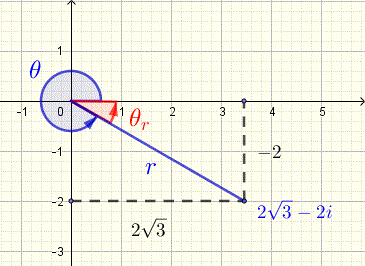Solution to Example 1
See graph below of plot of \(z\) on complex plane.

\( r = \sqrt {(2\sqrt 3)^2 + (2)^2} = 4\)
We need to find the reference angle \( \theta_r \) in order to find angle \( \theta \).
\( \theta_r = \tan^{-1}\left|\dfrac{b}{a}\right| = \tan^{-1} \dfrac{\sqrt 3}{3} = \dfrac{\pi}{6}\)
The real part of \(z\) is positive and its imaginary part is negative, hence the terminal side of the argument \( \theta \) is in quadrant IV (see plot of \( z \) above).
We now calculate \( \theta \) as follows:
\( \theta = 2\pi - \theta_r = 2\pi - \dfrac{\pi}{6} = \dfrac{11\pi}{6}\) (see plot of \( z \))
\( z \) in polar form is given by
\( z = 4 \left(\cos(\dfrac{11\pi}{6})+ i \sin(\dfrac{11\pi}{6}) \right) \)






